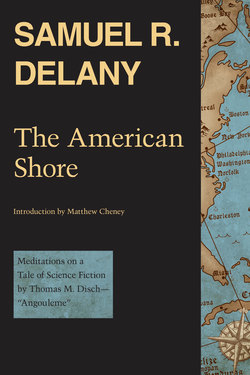Читать книгу The American Shore - Samuel R. Delany - Страница 11
На сайте Литреса книга снята с продажи.
1 The Pretext
ОглавлениеConcatenated texts—romans fleuves, interrelated series of novels and stories, stories and plays—appear from time to time in mundane fiction. Sometimes the connecting link is so tenuous as to constitute the merest ornamentation, a grace note to the text (as when the imprisoned Mersault, in Camus’s novel L’Etranger, comes upon a newspaper article that incidentally summarizes Camus’s play Le Malentendu); sometimes the links are forged of the unmalleable ore of naturalistic fiction: recurrent characters, settings, themes (as with the Forsytes, the Compsons/Snopeses/Sartorises, Leatherstocking, Tarzan, or the Thibaults).
If subjective time laid down through real history is the road on which mundane fiction travels, holding up now and again its Stendhalian mirror to view another roadside attraction, the tour de force of keeping, through several texts, to one lane of the highway is certainly intriguing, indeed laudable, even applaudable. But the possibilities of science fiction open up that highway into a boundariless plane, a whole prairie whose circling horizon is the limit of imagination itself, a prairie which quickly deliquesces into a roiling ocean of possibilities. The science fiction writer who returns, through several texts, to trace a single current in this ocean is, because of the oceanic context, involved in an undertaking of a very different order from the one-lane exploration of the mundane fictioneer.
The novel series in English language mundane fiction is rare and is usually connected with some feeling of provinciality (Faulkner, Powell, Cooper); and the mundane story series (e.g., Hemingway’s Nick Adams tales, Sherwood Anderson’s Winesberg) frequently carries with it as well the bad taste of editorial coercion, or at least the quotidian pressure to sell. Yet s-f authors as different as Laumer and Le Guin, Anderson and Aldiss, Russ, Niven, Zelazny, Farmer, Asimov, Anthony, Ballard, Bradley, Blish, Heinlein, Stableford, Moorcock, McCaffrey, Sturgeon, Andre Norton, “Doc” and Cordwainer Smith, Stanley G. Weinbaum, Stanislaw Lem, Zenna Henderson, Fritz Leiber, and Arthur C. Clarke have all produced either story-, novel-, or story-and-novel series.
In science fiction the creation of enchained texts bridges political opinion, aesthetic preferences, commitments to hard- or software, and spans all degrees of aesthetic merit. In science fiction the question is rather what writers have not at one time or another in their writing career chosen to interlink such a series, to generate such a set of texts within a single encompassing imaginative matrix. (Alfred Bester is one major name that comes readily to mind who has not left us, somewhere in his oeuvre, such a concatenation; C. M. Kornbluth is another.)
The explanation we sometimes read for the number of s-f series (“Well, readers buy series stories …”) attempts to establish a naive causality around the implicit commercial parameters of the field (“… therefore writers write them”). But we are aware just how strong the commercial parameters of s-f are. Such parameters’ mechanics are clear: because there is comparatively little money in science fiction, when commercial pressures work at all to contour a text or set of texts, they work (short of editorial tampering) in comparatively subtle ways1 and usually at several removes. Any explicit appeal to positive commercial pressures (negative ones, i.e., the pressures accruing from too little pay, contour another tale entirely), especially in a causal mode, is invariably aggrandizing mystification: to exaggerate the power of money in the field is to suggest that there is more money in the field than there actually is. The appeal defuses science fiction. In a capitalist society, to say, “These writers write for money …” makes the science fictional enterprise safe.
To say—and in so saying come far closer to spearing the thrashing, slippery truth—that this s-f writer writes out of some fanatical concept of ideology and that one out of an equally fanatical concept of aesthetics, that a third writes from ill-understood subconscious heavings that barely emerge into comprehensible prose, while another writes from a matrix of social prejudices and aesthetic rigidities, while still another writes to save the world from these same rigidities; and still others write from every combination of the above; and, though not much, they are all paid for it; and their collective fans hold hundreds of conventions a year, organized around their work, to which upon occasion many thousands come—this establishes a far more dangerous enterprise, a danger which “We write for money” is uttered, like a magic formula from the capitalist grimoire, precisely to subdue, to tame.
Science fiction readers like series stories; science fiction writers write them. But psychological synchronicity better explains the relation than any commercial causality: both readers and writers of s-f experience the field-effect of science fiction as a vast turbulence of “perhaps’s.” This turbulence is far stronger for science fiction than it is for mundane fiction.
Before such oceanic turbulence the need for coherence becomes far stronger than before mundane fiction’s pavic2 calm. The s-f series story answers that need in both the writer and the reader. The resultant cash flow is a secondary, if supportive, effect—not a primal cause.
“Angouleme” is the third written story in such an s-f series.
1. The comparison is specifically with movie, television, and “manufactured” best-seller writing, where a writer is paid a sum, frequently hundreds of times that which an s-f writer commands for equal wordage, basically to suffer the abuse entailed in becoming, essentially, an advisory scribe to an hysteric committee which decrees, sometimes page by page, what will and what will not be in the text, and which commands enough advertising funds to then parlay the practically lifeless product to some sort of profit.
2. Pavic, paved over or relating to pavement.
